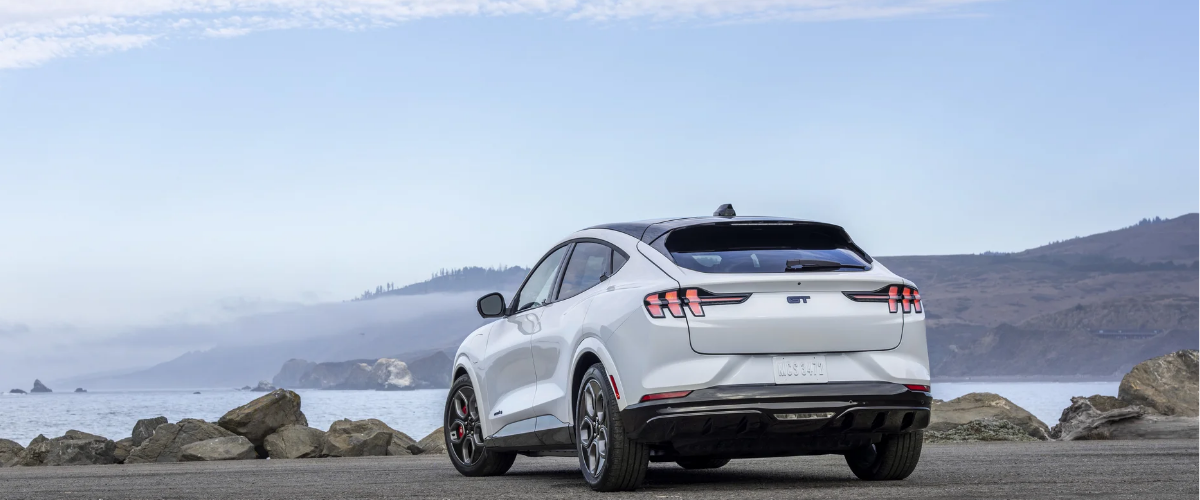The 2026 Mustang Mach-E GT California Special Breaks Cover

Solar and Roofing Advisor
The $7,500 federal EV incentive may be gone, but Ford’s 2026 Mach-E GT California Special brings fresh excitement to electric mobility.

In the midst of policy shifts and economic uncertainty, Ford Motor Company is taking a confident stance on electric vehicles (EVs). Just weeks after the expiration of the federal EV tax credit, the automaker has unveiled the 2026 Mustang Mach-E GT California Special, a heritage-inspired electric SUV that blends nostalgia, performance, and sustainability at a pivotal time for the industry.
While critics see the loss of the $7,500 federal incentive as a blow to the EV market, Ford’s strategy signals something deeper: that American automakers, consumers, and clean-energy advocates are entering a new phase of electrification — one driven by choice, innovation, and long-term confidence rather than government subsidies.
The Turning Point: EVs Without a Safety Net
On September 30, 2025, the federal EV tax credit officially ended, marking the close of a major chapter in U.S. clean-transportation policy.
The program had long served as a catalyst for electric adoption, reducing upfront costs for millions of buyers. In the final weeks before the deadline, EVs accounted for more than 12 % of all new U.S. vehicle sales, up from roughly 6 % a year earlier.
But the sudden removal of the incentive triggered predictable turbulence. By mid-October, EV market share dipped to around 5 %, as reported by several industry trackers.
Yet automakers like Ford, Hyundai, and GM have refused to slow down — doubling down on manufacturing, battery innovation, and software integration to prove EVs can thrive on merit.
“Electrification isn’t a phase,” one Ford spokesperson said. “It’s the foundation of the next century of mobility.”

The 2026 Mustang Mach-E GT California Special
Ford’s latest move is both a brand statement and a cultural message.
The 2026 Mustang Mach-E GT California Special package evokes one of the most iconic sub-brands in American automotive history, while pushing it firmly into the electric era.
The project was led by Stefan Taylor (exterior design) and Kristen Keenan (color & materials), both Mustang enthusiasts and long-time community figures who’ve spent years connecting with fans at car shows and meet-ups. According to the team, the inspiration came directly from the grassroots Mustang community’s growing enthusiasm for electrification.
“At Mustang events, you see personalization everywhere,” Taylor explained.
“We wanted to give fans something that celebrates individuality — and acknowledges that performance can be electric.”
Design Highlights
The California Special trades traditional racing red for a new chromatic blue — “Rave Blue” — that shifts from deep violet to ocean-bright depending on the light. The finish, paired with distinctive grille accents, wheel details, and subtle GT badging, gives the Mach-E a recognizable yet sophisticated profile.
As Keenan notes, “Blue felt like California — ocean, freedom, movement. It was never about politics; it was about emotion.”
Pricing and Rollout
The package adds $2,495 to the Mach-E GT’s base MSRP of $53,395.
The full 2026 Mach-E lineup opens for orders on October 22, with deliveries expected in Q1 2026. The standard range starts at $37,795, a competitive price given battery-material inflation and supply-chain constraints across the sector.
California’s Continuing Influence on the EV Market
Despite the credit expiration, the Golden State remains the beating heart of America’s EV market.
As of Q3 2025, California accounted for 29 % of all U.S. electric-vehicle sales, with more than 124,000 fully electric vehicles registered in just one quarter.
While Tesla’s Model Y and Model 3 still dominate the leaderboard, Ford’s Mach-E held its own — ranking fifth nationwide with 5,594 units sold in the first half of 2025.
Analysts point out that the connection between EVs and California goes beyond branding.
The state’s climate goals, clean-air standards, and public charging infrastructure create a feedback loop that drives continued EV adoption, even without federal incentives.
“California’s market fundamentals — population density, innovation culture, and regulatory support — make it self-sustaining,” said one EV analyst. “Manufacturers that build for California tend to build for the future.”
Beyond Cars: The New EV Economy
Ford’s confidence doesn’t exist in a vacuum. The post-credit era of 2025 is defining new priorities for the EV ecosystem:
- Battery Production & Vertical Integration — U.S. automakers are expanding domestic battery facilities to meet Inflation Reduction Act sourcing rules and reduce reliance on imports.
- Software-Defined Vehicles — Subscription-based features, predictive maintenance, and AI-driven performance optimization are becoming key differentiators.
- Charging Infrastructure Expansion — Private investment continues to pour in, bridging the gap left by slow federal grant rollouts.
Meanwhile, Charging-as-a-Service (CaaS) models are emerging to tackle one of the EV market’s biggest barriers: access for renters and multifamily dwellers.
Under these systems, charging providers install, own, and manage stations, while building owners simply pay a usage fee or revenue-share — a model that could unlock millions of potential new EV buyers nationwide.
The Cost Equation: Total Cost of Ownership Still Wins
Even without the $7,500 rebate, EVs remain cost-competitive thanks to reduced maintenance and lower fueling costs.
According to new analyses from Energy.gov and the International Council on Clean Transportation (ICCT), EV drivers still save an average of $800–$1,200 annually compared with gasoline counterparts.
Battery prices — once the single largest cost driver — have fallen by roughly 9 % since 2024, reaching an average of $111 per kWh. That’s expected to dip below $100 by 2026, pushing EV price parity even closer to combustion vehicles.
For consumers, that means the EV payoff now comes less from rebates and more from total ownership efficiency — an area where Ford and other manufacturers are focusing heavily through improved battery management systems and software updates that extend range and durability.
Market Reality: Short-Term Dip, Long-Term Growth
Analysts expect a temporary softening of EV sales through early 2026 as incentives phase out and consumers adjust. However, projections from Bloomberg NEF and IEA suggest the U.S. EV market will rebound quickly, with EVs representing 20 % of all new-car sales by 2028.
Ford’s approach — using nostalgia and design storytelling to strengthen emotional connection — could prove smart. The California Special label appeals to heritage buyers who may have resisted EVs, giving Ford a cultural bridge to convert traditional Mustang fans.
“We’ve reached the moment where EVs have to win hearts, not just wallets,” said one industry strategist. “That’s what Ford’s trying to do.”
The Broader Energy Shift: From Roads to Roofs
The end of the EV tax credit doesn’t just reshape the auto market — it also underscores a broader truth: America’s clean-energy transition now depends on self-sufficiency.
Every new EV added to the grid increases electricity demand, placing pressure on generation capacity and infrastructure. As a result, the synergy between electric mobility and renewable generation — especially rooftop solar and home battery storage — is becoming a defining theme of the late 2020s.
Industry data shows that nearly 38 % of new EV owners in 2025 are also considering home solar installation within 12 months of purchase. The logic is simple: owning both an EV and a rooftop solar array dramatically cuts lifetime energy costs and carbon footprint.
Industry Perspective: Innovation Through Adversity
Historically, crises and policy shifts have driven technological leaps. The 2025 tax-credit expiration may prove no different. Automakers, utilities, and renewable-energy firms are now aligning toward a shared goal — to make electrification economically self-sustaining.
While Ford’s California Special may appear symbolic, it represents a growing trend: legacy companies embracing disruption rather than resisting it. From battery recycling programs to vehicle-to-grid (V2G) pilot projects, the industry is rapidly connecting transportation, housing, and renewable power into a single ecosystem.
Why This Moment Matters
In many ways, Ford’s timing couldn’t be better. Consumers are more informed, more tech-savvy, and increasingly value energy independence. Even amid inflationary pressures, surveys show 78 % of Americans view EVs as the “inevitable” future of transportation. The emotional barrier — not the technological one — remains the last frontier.
By leaning into its most recognizable icon, Ford has delivered a clear message: the EV era isn’t just about efficiency or incentives. It’s about identity, performance, and pride — the same values that made American muscle cars cultural symbols for decades.
Clean Energy Companies Step Up: US Power & Qcells
The transition Ford embodies on the road mirrors what’s happening across the energy landscape at home.
US Power, a leading clean-energy installer, is at the forefront of that change — providing homeowners with high-efficiency solar panels and battery-storage systems designed for a future where electricity is generated, stored, and consumed locally.
Through its exclusive partnership with Q Cells, US Power delivers factory-direct, American-made solar technology that aligns with the same innovation-driven spirit powering the EV revolution.
As automakers electrify transportation, companies like US Power are electrifying the grid from the ground up — giving consumers control, stability, and independence in an uncertain energy market.
In short: the future of mobility and home power are converging.
And those who invest early — whether in an electric Mustang or a solar-powered home — are positioning themselves ahead of the curve.
The New American Drive: From Horsepower to Solar Power
The end of the federal EV tax credit may have closed one chapter, but it opened another — one defined by resilience, innovation, and integration. Ford’s 2026 Mustang Mach-E GT California Special is more than a car; it’s a symbol of how far electric mobility has come and where it’s heading next.
As automakers, energy firms, and consumers adapt to a world without subsidies, the winners will be those who embrace full-spectrum electrification — from vehicle to rooftop.
US Power stands ready to help households and businesses take that step with premium Qcells solar panels and advanced energy-storage solutions engineered for performance and reliability.
Schedule an appointment today to learn more about how solar + battery technology can power your home for decades to come.
Take charge of your energy future today.
Frequently Asked Questions
Related Articles
Our Related Blogs
Installing solar panels can increase home resale value across California today.
Stay updated on NEM 3 changes and what it means for California solar owners.
CA solar buyers, consider locking in US-made panels before import duty changes.
Our Solar and Roof Brand Partners








We empower communities and businesses to harness clean, renewable solar energy solutions that drive sustainable growth.
Ready to Own Your Power? Call us today!
818-650-8010
Copyright © 2025 US Power - Axia by QCells. All Rights Reserved.
Privacy is important to us, so you have the option of disabling certain types of storage that may not be necessary for the basic functioning of the website. Blocking categories may impact your experience on the website.
Essential
These items are required to enable basic website functionality.
Personalization
These items allow the website to remember choices you make (such as your user name, language, or the region you are in) and provide enhanced, more personal features.
Marketing
These items are used to deliver advertising that is more relevant to you and your interests.
Analytics
These items help the website operator understand how its website performs, how visitors interact with the site, and whether there may be technical issues.
We and our third-party partners use cookies and other technologies to enhance and track your experience on this site, conduct analytics, and personalize marketing to you. By using the site, you agree to our use of these technologies, including recording and monitoring your interactions with the site.
Get an instant solar estimate using satellite!









